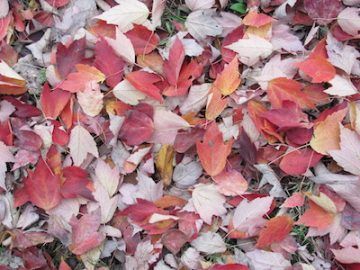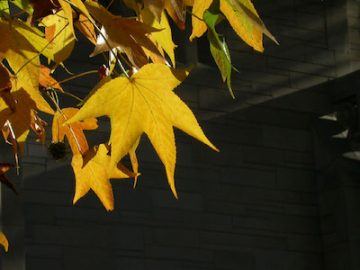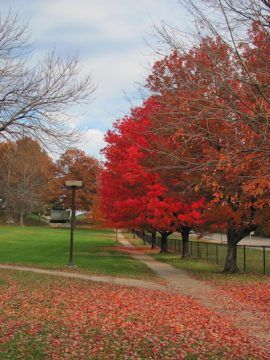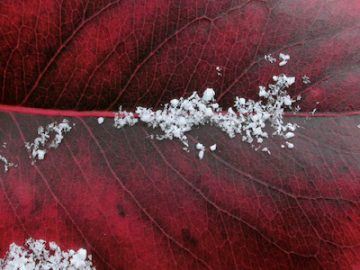by Mary Hrovat
 Autumn is brilliant. One of the things I looked forward to when I moved to the Midwest from the desert southwest was the experience of a year with four seasons. I did not anticipate how very beautiful autumn could be, and even after 40 years in the Midwest, I can’t get enough of this season. I can’t spend enough time outside in the wonderfully crisp air, under the low-angle sunlight, stopping to drink in the deep burnished golds, the lemony yellows, the gloriously variegated reds and oranges.
Autumn is brilliant. One of the things I looked forward to when I moved to the Midwest from the desert southwest was the experience of a year with four seasons. I did not anticipate how very beautiful autumn could be, and even after 40 years in the Midwest, I can’t get enough of this season. I can’t spend enough time outside in the wonderfully crisp air, under the low-angle sunlight, stopping to drink in the deep burnished golds, the lemony yellows, the gloriously variegated reds and oranges.
It took me a while to start recognizing specific types of trees instead of seeing only a mass of color, and I’m still learning new ones. I didn’t know until recently, for example, that the leaves of pawpaw trees turn the color of the sun in a child’s drawing. The pawpaw trees in my neighbors’ yard briefly cast a warm glow through my bedroom window on sunny afternoons this time of year. The leaves of ginkgo trees turn a similar color that deepens slightly with time; two huge old trees on campus drop countless small golden fans over the ground. (We won’t talk about the smell.)
I realize I have a surprising number of memories specifically about falling and fallen leaves: noticing dry leaves scurrying down the sidewalk, driven by a frisky wind on a cool autumn evening; pausing to watch a single yellow leaf drift to a rain-wet brick sidewalk under tenuous November sunshine as I hurried to a physics lab; seeing the perfect circles of red leaves on the ground under small maple trees; finding, one morning on my way to work, that an oak tree had dropped seemingly all of its leaves overnight, covering the sidewalk with a rich ruby carpet for me to walk on. Late one overcast afternoon last year, the clouds lifted near the western horizon, just enough for the setting sun to illuminate a maple with leaves that ranged in color from green to orange to scarlet. It blazed like a torch against an iron-gray eastern sky. I used to think moments like these pull me out of everyday life, but now I think they re-enchant it.

Autumn is a relief. On some autumn days, Earth seems to be glowing, burnished, ripe. It is as if “the globe itself were a fruit on its stem, with ever a cheek toward the sun,” as Thoreau wrote in his essay Autumnal Tints. In the days when agricultural cycles and our dependence on agriculture were much more obvious, and even to some extent today, autumn is about completion and the fulfillment of spring’s promise. “All is safely gathered in,” runs Henry Alford’s poem Harvest Hymn, “before the winter’s storms begin.” The word autumnal has connotations of a warm serenity that I associate with this sense of abundance and security.
The jubilation after a good harvest must have been mixed with considerable relief: the hardest work of the year was over, and there would be enough to eat (which could not have been taken for granted). I’ve always found autumn to be a relief for different reasons. The heat and humidity of summer start to feel like an assault after a while; they wear me down much more quickly than the cold of winter. I relax when I can open windows and curtains to welcome the warmth of the sun instead of trying to shelter against it. The mellowing and softening of the year are in themselves a cause for celebration even though I haven’t harvested so much as a single tomato.
Autumn is a season of preparation. As the year becomes cooler and darker, trees produce less chlorophyll; existing chlorophyll is broken down, and photosynthesis stops. In addition to chlorophyll, leaves also contain carotenoids (which are always present) and anthocyanins (which are produced in response to seasonal changes within and outside of the tree). In the absence of chlorophyll, these compounds are responsible for the beautiful colors of fall.
Trees shed their leaves, which are among their most vulnerable parts, in order to survive the winter. The sap is also drawn inward and downward to avoid damage due to freezing. Animals anticipate winter: some migrate, some enter a period of quiescence or torpor (the technical name for the state animals are in during hibernation).
Humans have their rituals of preparation as well. I close the crawl space vents, replace the furnace filters, and get out the winter clothes. Maybe I move the furniture around or do some deep cleaning in an attempt to make my nest as comfortable as I can for the cold indoor days ahead. I usually have some sort of reading project, a stash of books to keep me company on the long dark evenings. I don’t mind the cold, but I don’t look forward to the short dark days. It helps if I think of all the seeds and roots asleep in the dark ground that will waken in the spring, or if I can imagine the coming winter as a time to look inward, to spend more time reading and writing and dreaming.

Autumn is a season of endings. Thoreau saw the colorful leaves as having reached a perfect maturity, which he said is not to be confounded with the subsequent stage of decay. But really the period between the ripeness of the leaves and their decay is so short that we can be forgiven for lumping the two together. Those pawpaw trees go from green to yellow to skeletal in a few weeks, and the leaves wither on the ground.
In addition, trees shut down at different rates. (I asked a friend once why this is, and he told me they were expressing their genomes; I know that the word “express” in this context doesn’t mean what it does when we talk about humans expressing something, but still I like the echo of the human meaning that the phrase inevitably holds for me.) Some trees are alight with color while others are growing bare, their leaves crumbling underfoot. When it rains, the leaves form a sodden mass, and you can see that they’re on their way to becoming compost. The growing season is over, and nature is temporarily dying back. And of course, not all the days of autumn are sunny and pleasant; frosts and fogs and chilly rains show that winter is on the way.
Thoreau himself said of the leaves that “they teach us how to die.” He goes on to write, “One wonders if the time will ever come when men, with their boasted faith in immortality, will lie down as gracefully and as ripe,—with such an Indian-summer serenity will shed their bodies, as they do their hair and nails.” I suspect the association of aging, dying, and the dead with autumn in the human mind is a very old one.
In countless ways we are reminded that the year is drawing to a close. Even though you know there will be a new year, this one will never come again. (And a good thing too, you might think at the end of 2020. But still…it’s hard to think “good riddance” about an entire year out of the finite store each of us has.) Sometimes in autumn you hear the echo of all the doors that have closed softly and irrevocably behind you throughout the year. This is where the word autumnal gets its sense of bittersweet wistfulness.

Autumn is a phase in a never-ending cycle. Very early on a recent morning, I carried a spider outside and lingered a moment to look at the sky. The winter constellations, Taurus and Orion and Gemini, were high enough that I could trace the entire Winter Hexagon, which I haven’t been able to do since just after sunset in April. The entire year’s worth of constellations is always circling by overhead. Although some are lost in the glare of daylight at any given time of year, the constellations of the coming seasons are there late at night and early in the morning for you to see. On that particular morning, Venus shone low in the east near a waning moon, not too far from the stars of the constellation Leo, which appears high in the evening skies of spring.
Autumn marks the slow decay of summer and contains the seeds of winter, but in fact every season grows from the one before it and contains the seeds of the one that follows. The idea of firm boundaries like New Year’s Day is a human fiction. The year is a cycle with no beginning and no end, one that repeats endlessly. (Well, endlessly for all practical purposes, from the perspective of beings who live for 80 years.)
This continuity can be a comforting thought. The leaves that fall today will (if they are left alone) provide nourishment for the tree eventually, and the cycle will continue. Human finitude can be so poignant, though. Although the moon will wax again and wane and the seasons will continue to turn, someday I won’t be here to see them. Henry Dobson, in his poem The Paradox of Time, wrote “Time goes, you say? Ah no! / Alas, Time stays, we go.”
###
I used to think that in autumn I was trying to saturate my senses, fill my eyes with light and color before the bleak, unlovely winter arrived. But I’ve come to appreciate the subtle and austere beauties of winter, and I feel compelled to absorb the experience of cold weather and snowy or icy days. I also feel like I can’t get enough of spring as it slowly quickens the land, and even the hot humid summer has its riches. Now it seems that in any season, what I’m trying to soak up is life itself.
###
The first and third photographs are mine. The other two are the work of Patrick Alexander.
###
You can see more of my work at maryhrovat.com.
